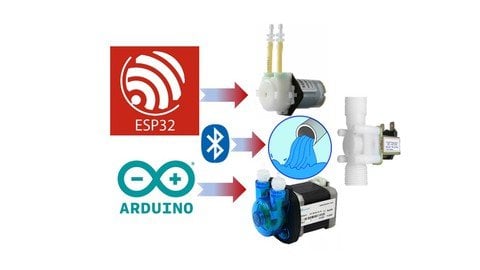
Published 12/2022
MP4 | Video: h264, 1280×720 | Audio: AAC, 44.1 KHz
Language: English | Size: 2.29 GB | Duration: 2h 29m
Simplifying automation
What you’ll learn
Learn different types of pumps and common liquid handling components used in the lab experiments.
Apply basic Arduino knowledge to control DC motor pumps.
Understand stepper motors and their used in accurate peristaltic and syringe pumps.
Make accurate peristaltic pump with wiring, programming, calibration and flow rate control using Bluetooth
Make accurate syringe pump with wiring, programming, calibration and flow rate control using Bluetooth
Requirements
Basic programming skills using Arduino IDE.
Basic knowledge about Arduino hardware.
Description
This is the third course in the DIY Lab Equipment with Arduino series. After we learnt the basics in the first course, now it is the time to learn about the low-cost off-shelf pumps and their accessories. For this course, it is not required to take the second course about Temperature Control but it is recommended since it has a lot of general useful resources like using SD card and display. Here we will APPLY this knowledge to control the liquid handling in our experiment setup or project. By controlling the pumps, it is easy to automate the experiment activities like taking samples, circulating liquid, mixing different liquids at specific ratio and specific time and many more.After learning the basics of pumps and how electrically simple they are, we move to learn how to program them using Arduino/ESP32. We learn simple control as ON/OFF in addition to flow rate control. We take a deep understanding of stepper motor peristaltic and syringe pumps and how to calibrate them and use Bluetooth to control the flow rate. Like other course, we use off-shelf components that are readily available at low cost.During this course, we practice how to utilize available codes from the internet or library examples and fit them in our project with minimal coding experience. If you have no knowledge about coding and Arduino, it is highly advised to take the first course (DIY Lab Equipment with Arduino-Part 1-The Basics).
Overview
Section 1: LIQUID FLOW CONTROL
Lecture 1 Introduction
Lecture 2 Types of pumps and their applications
Lecture 3 Liquid handling components – valves, tubes and fittings
Section 2: DC MOTOR BASED PUMPS
Lecture 4 DC motor pumps, wiring and coding part 1 – ON-OFF control
Lecture 5 DC motor pumps, wiring and coding part 2- flow rate control
Section 3: STEPPER MOTOR BASED PUMPS
Lecture 6 Stepper motor peristaltic pumps – part 1 – operation principle
Lecture 7 Stepper motor peristaltic pumps – part 2 – wiring, coding and flow control
Lecture 8 Stepper motor peristaltic pumps – part 3 – flow rate calibration
Lecture 9 Stepper motor peristaltic pumps – part 4 – flow rate control using Bluetooth
Lecture 10 Syringe pumps – principle and flow rate calibration
Students and researchers looking to customize the experiment setup.,Non-engineers looking to apply automation in their activities.,Anyone who needs to automate the transfer of a liquid.,Chemistry, biology, physics, biomedical, medical, pharmaceutical lab students, researchers and staff who need to make DIY equipment.
Password/解压密码www.tbtos.com
转载请注明:0daytown » Diy Lab Equipment With Arduino – Part 3 – Liquid Handling